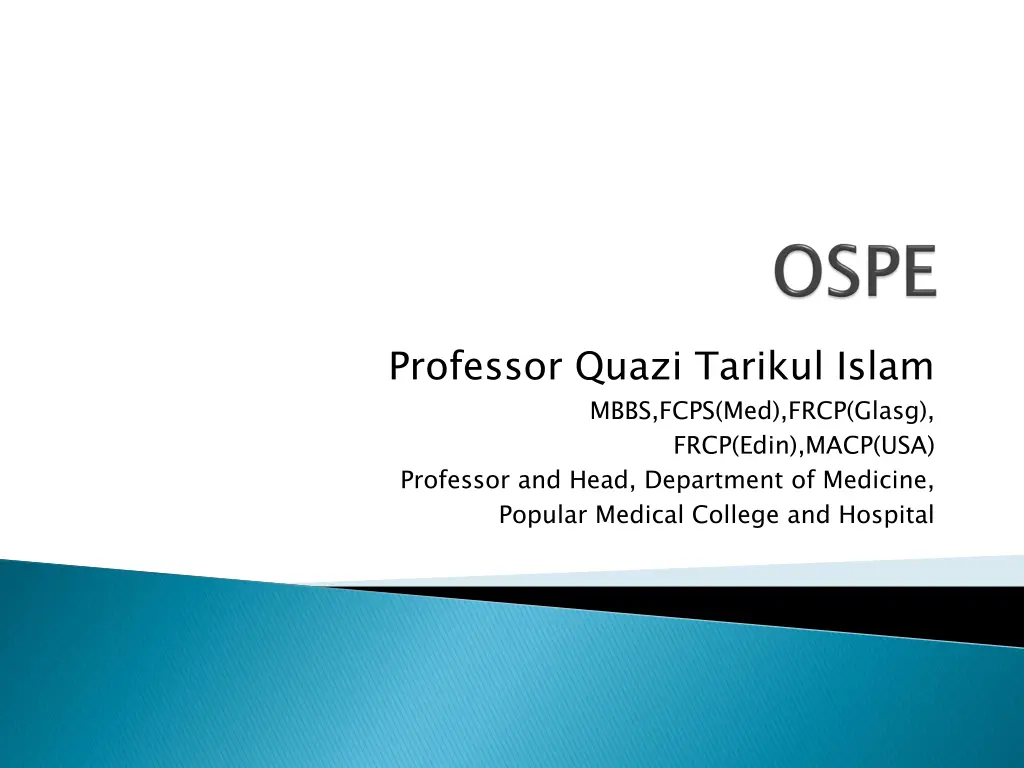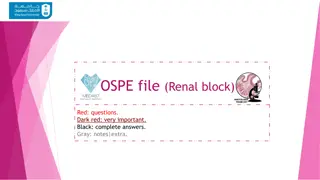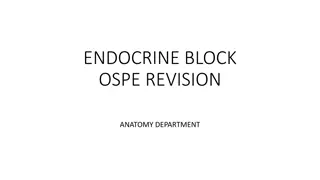
Identifying Medical Instruments and Their Applications
Explore the identification and use of medical instruments like lumber puncture needle and bone marrow aspiration needle, along with their indications, common sites, complications, and contraindications. Gain insights into the procedures and aspects of confirming correct placement.
Download Presentation

Please find below an Image/Link to download the presentation.
The content on the website is provided AS IS for your information and personal use only. It may not be sold, licensed, or shared on other websites without obtaining consent from the author. If you encounter any issues during the download, it is possible that the publisher has removed the file from their server.
You are allowed to download the files provided on this website for personal or commercial use, subject to the condition that they are used lawfully. All files are the property of their respective owners.
The content on the website is provided AS IS for your information and personal use only. It may not be sold, licensed, or shared on other websites without obtaining consent from the author.
E N D
Presentation Transcript
Professor Quazi Tarikul Islam MBBS,FCPS(Med),FRCP(Glasg), FRCP(Edin),MACP(USA) Professor and Head, Department of Medicine, Popular Medical College and Hospital
Ans1 Lumber puncture needle. Ans 2 Identifying points: a)It is tall & thin, metallic b)It has 2 parts: trocher & cannula/ stylet & spinal needle c) There is no guard Ans 3 Indications of the procedure performed by the instrument: A)Diagnostic: Meningitis / Encephalitis / GBS/ MS B)Therapeutic: Administration of intrathecal medications eg- Methotrexate in ALL/ Removal of CSF to lower the pressure in IIH C)Procedure: Spinal anaesthesia
Ans 4 The needle in usually inserted between lumbar spinous processes ( usually between L3 & L4) through the dura matter and into the subarachnoid space. Ans.5 a) clinical suspicion of raised intracranial pressure b) severe thrombocytopenia c) local infection Ans. 6 Complications of its use:(any 3) Spinal headache (30%) Transient radicular pain Pain over the lumber region during the procedure Infections such as meningitis are extremely rare ( provided an aseptic technique is used) Coning effect Ans. 7 Fundoscopy
Q.1 Identify the instrument? 1.5 Q.2 Mention its parts? 2 Q.3 Write down 6 Indications of the procedure performed by the instrument? 3 Q.4 mention Common sites of the procedure performed by the instrument? 1 Q.5 Mention 3 Complications of its use? 1.5 Q.6Write down 2 Contra- indications of the procedure? 1
Ans 1 bone marrow aspiration needle .Ans2 has 3 parts- trocher, cannula & a guard Ans 3 Leukaemia Aplastic anaemia Megaloblastic anaemia Multiple myeloma Idiopathic Thrombocytopenic Purpura (ITP) Kala-a-zar ( LD bodies) Ans 4 Manubrium sterni Posterior iliac crest Proximal part of tibia: if the age is below 2 years Ans 5 Pain at site of intervention Haematoma formation at the site of puncture Infection Ans 6 Severe thrombocytopenia( less than 10,000/cumm) Local infection at the site of puncture
Q.1 Identify the instrument Q.2Mention 4 aspects of its use with example of each ? Q.3 Mention the mark line over the instrument with justification Q.4 write down 4 procedure to confirm whether it is correctly placed or not? Q.5 Mention 1 of immediate and 1 late complication of its use 1 4 2 2 1
Ans1. Ans 2. Ryles tube/Nasogastric tube a)Nasogastric feeding for patients who cannot eat, eg.Unconscious patient b)NG suction eg. in patient of intestinal obstruction, acute abdomen c)Gastric lavage eg. in patients with drug overdose or poisoning d) Diagnostic eg.To collect fluid for gastric juice analysis. Ans 3 Ans. 4 If it is inserted into the respiratory tract, violent cough reflex will be initiated When the external end of tube is placed into water, if bubbles come out, the tube is in the respiratory tract Aspiration will bring out gastric contents if it is correctly placed. A few cc of air is injected into the tube and at the same time auscultation done over epigastrium , a gurgling sound will be heard over the epigastrium if the tube is in the stomach. a. mark 1 tip at lower of esophagus b. mark 2 tip at fundas of stomach c. mark 3 tip is at pylorus of stomach
Ans 5 Immediate-aspiration of gastric content/tube blockage Late-tracheo oesophageal fistula/metabolc complication.
Q.1 Identify the instrument? What are the parts ? Q.2 Mention 2 major diseases where the device can be used? Q.3 Write down the name of 3 groups of drug with one example and one side effect that can be used in the device? Q.4 What device need to be used in case of children or elderly to get maximum benefit? Q.5 mention 4 Advantages of its use over oral therapy? 2 1 1.5 x 3 =4.5 0.5 2
Ans 1 Metered dose inhaler, mouth piece, canister , device Ans 2-Asthma -COPD Ans 3Bronchodilators eg- salbutamol, salmeterol.S/E tachycarda. Steroids eg- beclomethasone, fluticasone.S/E oral candidasis Anticholenergic eg.ipratropium bromide.S/E dry mouth Ans 4 Spacer/respo chamber Ans 5a) Rapid onset of action b)A smaller dose of drug is required as the lungs provide wider area for absorption c)Lower incidence of side effects d)Increased efficacy of drug
A 45 year old male presented with progressive pallor, fever & gum bleeding for 1 month. Investigation revealed- CBC: Hb- 6 gm/dl Total count of WBC- 1000/ cumm Platelet- 20,000/ cumm ESR- 70 mm in 1st hour
Question 1: What is the haematological diagnosis? Question 2: Mention 3 possible causes. 3 Question 3: Mention 4 important physical signs you will look for. Question 4: Mention1 investigation to confirm your diagnosis. Question 5: Which group of drug can give rise to this type of blood picture? 1 4 1 1
Ans 1 Ans 2 Ans 3 Ans 4 Ans 5 Pancytopenia a)Aplastic anaemia b)hypersplenism c)Leukaemia a)anaemia b)bony tendernes c)bleeding menfestation/purpura d)Hepatosplenomegaly bone marrow examination cytotoxic drugs/chemotherapy
A 15 year old girl presented with scanty micturition & puffy face for 3 days. Urine routine & microscopic examination revealed Colour: Smoky Albumin + Pus cells : 0-2/ HPF RBC: 20-30/ HPF RBC cast: present
Question 1 : What is your clinical diagnosis? 1 Question 2: What important past history you want to ask the patient? Question 3:Write down 3 important physical signs you may get in this patient. Question 4: Write down 4 other necessary investigations for this patient. Question 5: Write down 2 complications of this condition if remain untreated. Question 6:How can you explain if this patient develops severe orthopnoea? 1 3 2 2 1
Ans 1 acute glomerulonephritis Ans 2 Scabies Ans3a)hypertension b)oedema c)Anaemia Ans 4 a. s creatinine b. s electrolyte, blood urea c.USG of KUB d. kidney biopsy Ans 5. a. hypertensive heart failure b. renal failure/ c. electrolyte imbalance Ans 6. a. hypertensive heart failure/LVF
A 18 year old diabetic boy on insulin presented to emergency department with the complaints of disorientattion & deep rapid breathing for 2 days . On query, his mother told that he has fever for 1 week & may has missed insulin doses
Q-1. What is your clinical diagnosis? Q-2. Write down 4 important other signs you may get? Q-3. Mention 4 most important investigations for her. Q-4. Write down 4 important components of management. 2 2 2 4
Ans 1 diabetic ketoacidosis Ans 2a.dehydration b.kussmaul breathing/smell of acetone in breath c.tachycardia/hypotension d.cold extremities/peripheral cyanosis Ans 3 a. blood glucose level b. blood/urine for ketone bodies c.s electrolyte d.s cr/blood urea nitrogen e.infection screen/CBC Ans 4 a. correction of dehydration/i/v fluid b. control of blood glucose/iv Insulin c. correction of electrolyte imbalance d. control of infection/management of other co-morbidities
A 50 year old male presented with blood report showing bilirubin 25 mg/ dl, SGPT- 60 U/L, Alkaline phosphatase- 1200 U/ L, prothrombin time-20 sec, control-12 sec. Question 1: What is your clinical diagnosis? Question 2: Mention 3 important clinical history you will take to reach a diagnosis. Question 3: Write 2 other important investigations you will do in this case. Question 4: Mention 4 important causes of this condition. 1 3 2 4
Ans 1 Obstructive jaundice Ans 2 a.itching b.pale stool c.fever/abdominal pain Ans 3 a.USG of HBS b.MRCP/ERCP Ans 4 a.choledocolithiasis b.carcnoma-ampullary/pancreatic/cholangiocarcinoma c.primary biliary cirrhosis/primary sclerosng cholangitis d.biliary stricture
Question 1:write down 2 positive finding? 1x2=2 Question 2: What is your diagnosis? 1 Question 3: Mention 4 important clinical signs you may encounter during examination of this child. 4 Question 4: Mention 3 important investigations with expected positive findings. 0.5x3=1.5 Question 5: What dieatry advice will you give this patient? 0.5 Question 6: Write down 2 side effects of repeated blood transfusion. 1
Ans 1 a. flat nasal bridge b. malar eminence Ans 2 Congenital haemolytic anaemia Ans 3 anaemia -jaundice -spenomegaly -hepatomegaly Ans 4 CBC -PBF -HB electorphoresis Ans 5 avoide excess iron containing diet Ans 6 transmission of HBC HCV -secondary haemochromatosis
Question 1:Mention 2 positive findings? Question 2: What is the most likely diagnosis? Question 3: Write down other 3 important deformities which may be found in the hand. Question 4: Write down 4 investigations used to support your diagnosis. Question 5: Mention 4 groups of drugs with example from each group which are used for treatment of this patient. Question 6: Mention 2 investigations used for monitoring the drug safety. 1 0.5 1.5 2 4 1
Ans 1 a.swan neck deformity of fingers b.wasting of hand muscles Ans 2 Rheumatoid arthritis Ans 3 a.boutonniere/button hole deformity b.Z deformity of thumb c.dorsal subluxation of ulna/ ulner deviation Ans 4 a.CBC ESR b.CRP c.RA factor d.anti CCP antibody Ans 5 a.NSAID indometacin/naproxen b. steroid-prednisolone c.DMARD-methotrxate/hydroxichloroquine/tofacitinib d.biologics- rituximab /inflximab /Adalimubab Ans 6 a.CBC b.SGPT/s cr
Question 1:mention 2 most important findings of the picture? Question 2: What is your clinical diagnosis? Question 3: Write down 2 other important clinical signs which may be encountered during examination of her eyes. 2 Question 4: Name 4 investigations to reach a diagnosis. 2 2 1 Question 5: Write down the modalities of treatment with 1 indication of each. 3
Ans 1 a.enlarged thyroid gland/goiter b.exopthalmos Ans 2 thyrotoxicosis/ Grave s disease Ans 3 a.lid lag b.lid retraction c.chemosis d. opthalmoplegia Ans 4 a.TSH,FT4,FT3 b.USG of thyroid gland c.anti TR antibody/ anti TPO ab/ anti TG ab d.thyroid scan/FNAC of thyroid gland Ans 5 a.antithyroid drug-first episode in patients < 40 years b.radio iodine age> 40 years/recurrence after surgery c.surgery large goiter/drug failure
Question 1:mention most important findings of the picture? 2 Question 2: What is your most likely clinical diagnosis? 2 Question 3: Write down the name of the organism of your most likely diagnosis? Question 4: Name 3 investigations to reach a diagnosis. 3 1 Question 5: Mention the drug of choice. 2
Ans.1: Unlateral leg oedema/swelling/non pitting oedema Ans.2: Lymphatic filariasis. Ans.3: Wuchereria Bancrofti Ans.4: a. CBC/Eosinophil count Ans.5: Diethylcarbamazine b. Detection of microfilaria in PBF c. Filaria serology/ ICTor ELISA


